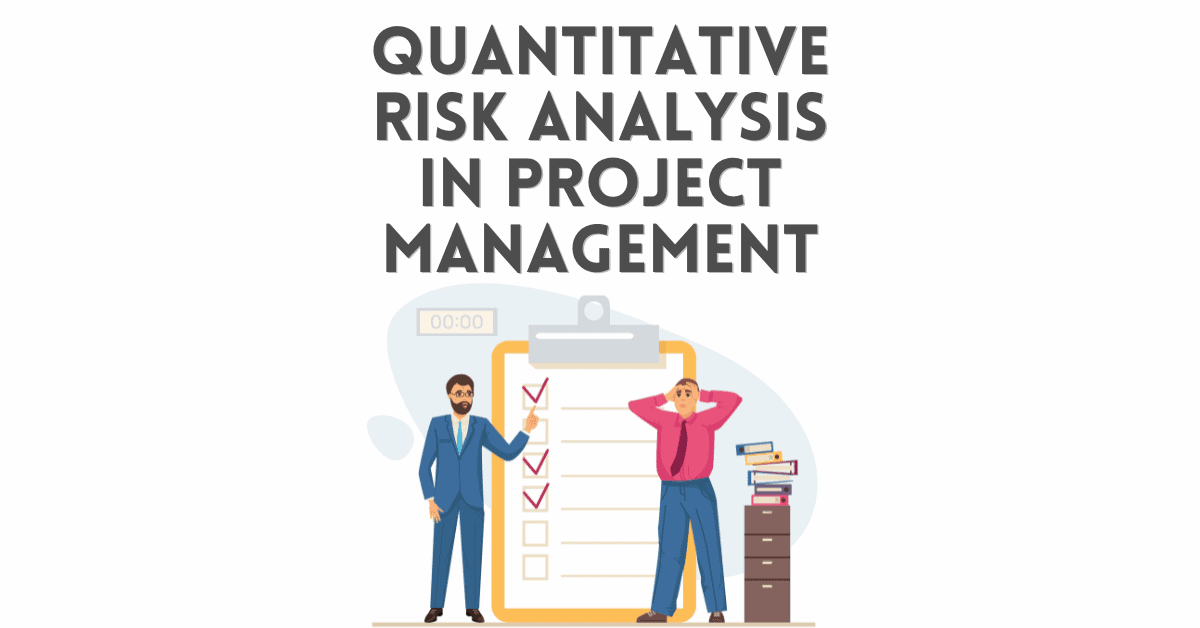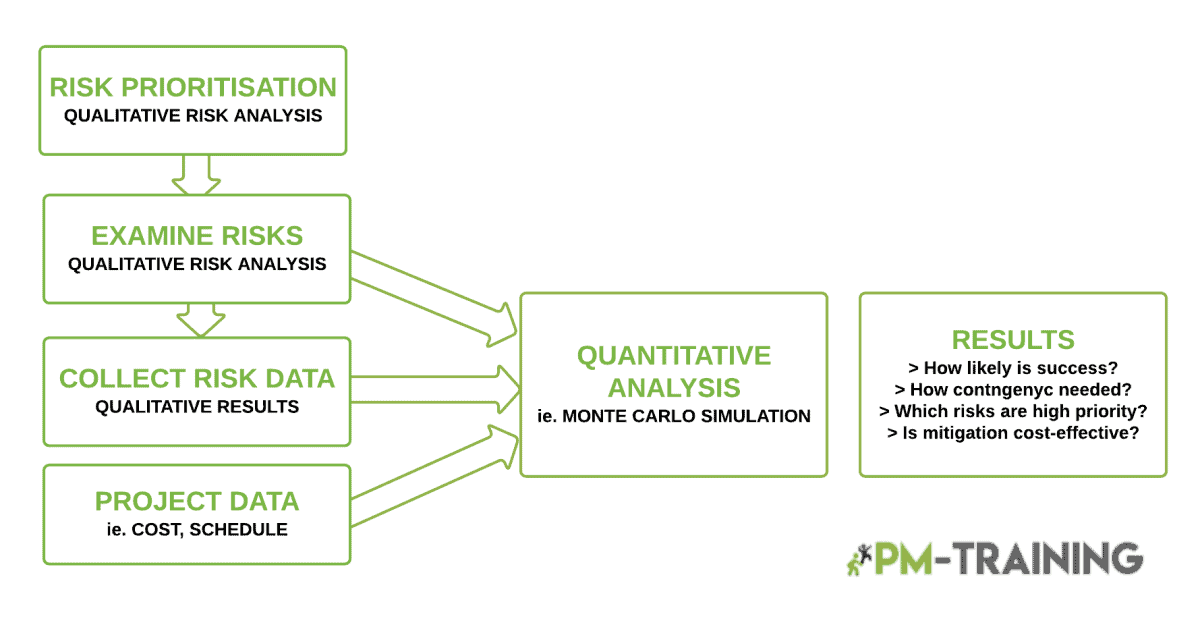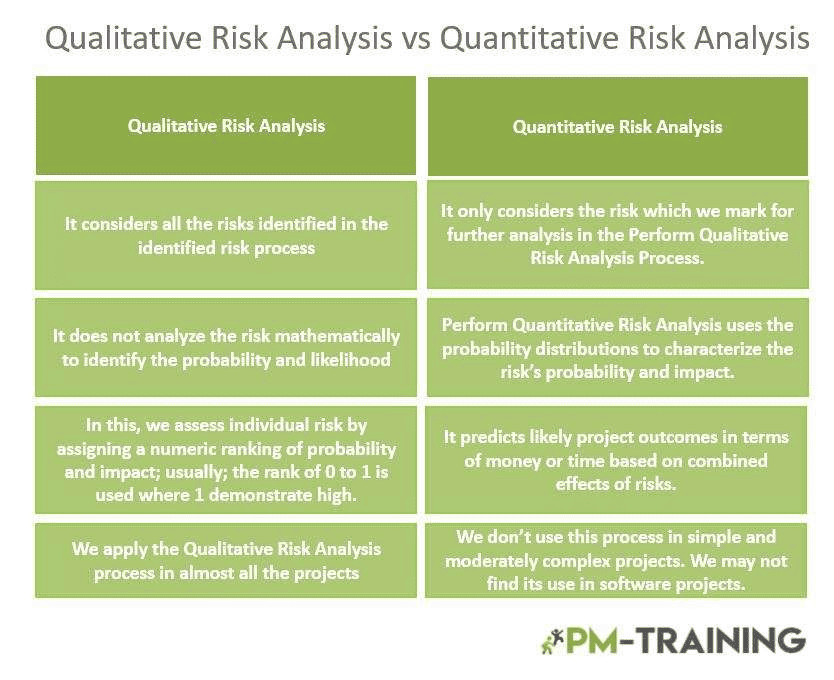
Quantitative risk analysis (QRA) assists in identifying factors impacting individual projects or organizations by applying research methodologies to measure and project future conditions.
This type of analysis takes the probability and impact of risks on a project or organization using numerical data, thus creating a quantitative risk assessment (QRA). In addition to numerical data, the analysis is supplemented with statistical tools and analytic techniques
An example of this includes, but is not limited to, decision trees, simulation modeling, Markov chains, Monte Carlo simulations, expected monetary value (EMV) calculations, and actuarial risk analyses.
Even though QRA falls under the category of qualitative analysis in most organizations, it has become so large that it is now considered one of the most critical project management processes for quantitative forecasting.
Quantitative Risk Analysis PMP Overview
The first step in risk management on any project is to identify the risks that could happen, determine which are most likely to occur, and work on mitigating them. Quantitative risk analysis (QRA) is how you do this.

QRA is most effective at the business or portfolio level and less effective for project-specific risk analysis. With QRA, it is possible to estimate the probability of various risks occurring in the future and how they will affect performance.
It can provide an overall picture of the likelihood of achieving project objectives based on one or more scenarios. It provides insights into what could go wrong and why to establish a better course of action (or inaction). This approach has been shown to help leaders make better decisions that directly impact their ability to achieve strategic results.
In most cases, PMI encourages organizations to utilize quantitative forecasts for resources required over periods rather than just hard numbers with high accuracy. Furthermore, QRA helps determine the most effective strategy for risk response planning, which is why it’s essential to utilize this process when developing a portfolio.
What is the Purpose of Quantitative Risk Analysis
The purpose of quantitative risk analysis is to give insight into the probability of potential future events by providing numerical data rather than merely assessing qualitative risk.
This type of risk analysis calculates quantitative future values for uncertain vital variables at specific points in time. It applies statistical techniques and simulation modeling to measure future conditions using historical data, expert opinions, or assumptions before making projections about the probability of certain events.
With this knowledge, it is possible to assess if plans are integrated (and how they work together), identify the likelihood that each project objective will be met, determine which risks pose the highest risk to performance, assess whether action should be taken, and decide how an organization can best respond.
This process often helps companies decide between two or more courses of action to increase organizational success. Furthermore, with this information, users can plan and prepare to manage risks and spread the momentum created by positive results.
Quantitative risk analysis helps identify risk factors that could occur and pose the most significant risk. Lastly, quantitative risk analysis is based on probability (the chance that something will happen with numerical odds) rather than possibility (what might happen if certain conditions are met with varying degrees of probability).
Organizations use this process to determine how effective their current strategies for success would be under different conditions.
Quantitative Risk Analysis Techniques and Methods
There are several quantitative risk analysis (QRA) techniques and methods that can be used:
- Monte Carlo Simulation: This technique has created more accurate risk forecasts than other models. It is typically used with simulation modeling by creating a range of values for each variable in the model and using probabilities as an input to run simulations thousands or millions of times to generate possible outcomes.
- Expected Monetary Value Calculation: This type of QRA calculates the predicted value based on risk probabilities and impact, so it only considers the most likely risks. It can be applied whether there’s one individual project or multiple projects and organizations involved. The expected monetary value calculation essentially means multiplying the likelihood of a particular event occurring and the impact of that event.
- Scenario Analysis: This type of QRA calculates the possible range and likelihood of different project outcomes, and it helps determine whether a desired result can be achieved within an organization’s risk tolerance level. With this technique, management teams create multiple scenarios (or stories) about what could happen—good or bad—to make decisions. It helps answer questions such as how many resources are needed and when they will be required (if at all).

A structured and standardized approach is the most effective way to conduct quantitative risk analysis. This approach has been shown to help leaders make better decisions that directly impact their ability to achieve strategic results.
Quantitative Risk Analysis Example
When developing a portfolio, QRA can be used to determine the most effective strategy for risk response planning. This is why it’s important to utilize this process.
For instance, an organization may use the quantitative risk analysis method of scenario analysis to assess whether or not projects are integrated. A leader would start this process by asking questions about what could happen—good or bad—to make decisions based on possible outcomes. From there, managers could decide between two or more courses of action that will increase organizational success. The benefit here is that all scenarios (or stories) about what could happen are considered in determining which option provides the best chance for positive results.
Once the person conducting the QRA has identified all sources of risk, they should work with management to develop a plan for each source of risk. For example, if one area is likely to have three adverse events that could occur during the next year within an organization, then perhaps having ten resources on hand would be sufficient. On the other hand, if four areas are likely to have eight positive events in a given year, having 15 resources available would be more suitable for this scenario. Because scenarios are being considered at this stage, management teams must establish clear expectations before implementing changes.
If risks cannot be removed or transferred and exceed the organization’s threshold levels (i.e., acceptable risk or not), resources may need to be reallocated. For example, suppose adverse events outweigh the positive within an organization’s portfolio, and it becomes clear that there’s too much risk. In that case, management teams can determine whether or not something needs to change, such as dropping specific projects altogether.
When performing a quantitative risk sensitivity analysis, it’s important to remember that poor assumptions (i.e., uncertainty) and unknown circumstances could affect the results. Because of this, managers need to consider all possible outcomes when conducting QRA so they can make decisions based on data rather than emotions. This is done by identifying sources of risk and devising appropriate strategies for achieving success.
Qualitative Risk Analysis vs Quantitative Risk Analysis

- A) Quantitative risk analysis helps leaders make informed decisions by providing two or more data-based courses of action. Qualitative risk analysis, on the other hand, is less structured and relies more heavily on managers’ decision-making abilities.
- B) A qualitative risk analysis can provide insights into what could happen positively or negatively while helping decision-makers determine the best response. Quantitative risk analysis lacks this level of detail since it focuses on projecting financial data rather than gaining stakeholder insights.
- C) Quantitative risk analysis helps leaders make more strategic decisions by giving them access to specific details about what could happen in various situations. More importantly, this method provides more significant opportunities for positive outcomes, as managers can “write the story” about what could happen and gather data to support such conclusions.
- D) Quantitative risk analysis is more structured than qualitative risk analysis but doesn’t give leaders detailed information about what could happen in specific scenarios. Qualitative risk analysis lacks structure and focuses solely on understanding stakeholders’ opinions.
Conclusion
In conclusion, the PMBOK recommends that all projects have a risk management process that includes identifying and mitigating risks. Qualitative analysis is used first to identify potential threats. Then, when it is time to decide which threats are most likely to occur, quantitative analysis comes into play. The final product of this methodology is a project plan with a better understanding of how much the project will cost and how long it will take. This information can be beneficial in determining if current conditions could place the company’s business continuity at risk before making any decisions.
Shane Drumm, holding certifications in PMP®, PMI-ACP®, CSM, and LPM, is the author behind numerous articles featured here. Hailing from County Cork, Ireland, his expertise lies in implementing Agile methodologies with geographically dispersed teams for software development projects. In his leisure, he dedicates time to web development and Ironman triathlon training. Find out more about Shane on shanedrumm.com and please reach out and connect with Shane on LinkedIn.